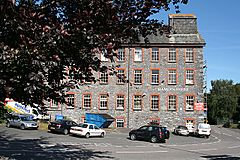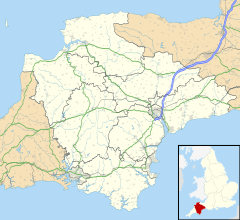Buckfastleigh facts for kids
Quick facts for kids Buckfastleigh |
|
|---|---|
 Hamlyn House |
|
| Population | 3,326 (2011) |
| OS grid reference | SX7366 |
| Civil parish |
|
| District |
|
| Shire county | |
| Region | |
| Country | England |
| Sovereign state | United Kingdom |
| Post town | BUCKFASTLEIGH |
| Postcode district | TQ11 |
| Dialling code | 01364 |
| Police | Devon and Cornwall |
| Fire | Devon and Somerset |
| Ambulance | South Western |
| EU Parliament | South West England |
| UK Parliament |
|
Buckfastleigh is a fun market town in Devon, England. It sits right next to the Devon Expressway (A38) and is close to the amazing Dartmoor National Park. This town is part of Teignbridge and has about 3,661 people living there.
Buckfastleigh is a popular place for visitors. You can find many cool attractions here. These include Buckfast Abbey, the South Devon Railway, and even a Butterfly Farm and Otter Sanctuary! It's also known for the mysterious Tomb of Squire Richard Cabell.
Did you know Buckfastleigh has 13 letters? It's one of the longest place names in England without any repeated letters! Only Bricklehampton in Worcestershire is longer, with 14 letters.
Contents
- Exploring Buckfastleigh's Geography
- A Look Back at Buckfastleigh's History
- The Mystery of Brook Manor House and Sherlock Holmes
- Riding the South Devon Railway
- Buckfast Abbey: A Place of History and Peace
- Buckfastleigh Rangers Football Club
- Famous Connections from Buckfastleigh
- Exploring Local Caves
- Images for kids
- See also
Exploring Buckfastleigh's Geography
Buckfastleigh is built where two small streams from Dartmoor meet. These streams then flow into the River Dart just east of the town. About a mile north, you'll find Buckfast, home to the famous Buckfast Abbey.
To the northwest are the villages of Holne and Scorriton. These are on the edge of the Dartmoor uplands. You can also find Pridhamsleigh Cavern nearby. The towns of Ashburton and Lower Dean are also close.
A Look Back at Buckfastleigh's History
Buckfastleigh grew up as a "mill town." This means it was known for its woollen mills, corn mills, paper mills, and a tannery. These businesses used the water from the rivers Dart, Mardle, and Dean Burn. Water was super important for making wool and other products!
The town of Buckfastleigh is very old, going back to medieval times. You can still see its original layout today, especially in Fore Street. By the 1600s, most buildings had been rebuilt.
The name "Buckfast" means "stronghold," a place where deer were kept. "Leigh" means pasture. So, Buckfastleigh means "deer held in a pasture."
Buckfast probably existed before Buckfastleigh. It's mentioned in a very old book called the Domesday Book. In 1018, a Benedictine Abbey was started there by King Canute.
Today, the town centre has many buildings from the late 1700s to early 1900s. They still have their original look and feel. In the early 1900s, Buckfastleigh was a busy place. It had lots of local jobs and new houses were built. In 1801, about 1,525 people lived here. By 1901, the population grew to 2,781.
The Hamlyn family owned the biggest woollen mills in town. In 1880, they built a large house called Bossell. In 1887, they helped build Buckfastleigh Town Hall. This was to celebrate Queen Victoria's Golden Jubilee.
Land was also given for public places like Victoria Park, tennis courts, and a swimming pool. A new primary school was built in 1875. The railway line to Totnes opened in 1872. While passenger trains stopped in 1958, you can still travel to Ashburton and Totnes by bus.
Just outside town, you can visit Pennywell Farm. It's an organic farm and a fun tourist attraction.
The Mystery of Brook Manor House and Sherlock Holmes
West of town is Brook Manor House. This old house was built in 1656 by Richard Cabell. He was the lord of the manor of Brook. A local legend says that on the night he died, black hounds breathing fire raced over Dartmoor. They surrounded Brook House, howling loudly.
Cabell's unusual tomb was supposedly built to keep his spirit from wandering Dartmoor. The famous writer Sir Arthur Conan Doyle used this legend. He based his Sherlock Holmes novel The Hound of the Baskervilles (1901–1902) on this spooky story!
Riding the South Devon Railway
The South Devon Railway Trust runs a special heritage railway. It goes from Totnes to Buckfastleigh, following the River Dart. This railway is also called the South Devon Railway. It's named after the original company that built many railways in Devon.
The line first opened on May 1, 1872. It used to connect Totnes with Ashburton. But the part between Buckfastleigh and Ashburton was removed for the A38 expressway.
On this railway, you can ride vintage steam locomotives and carriages. It's like stepping back in time! You'll see unique scenery only visible from the train. The South Devon Railway has a cool collection of both steam and diesel engines. They work with the National Railway Museum to keep these old trains running.
Buckfast Abbey: A Place of History and Peace
Buckfast Abbey was started by Earl Aylward in 1018. This was during the time of King Canute. In 1147, it became a Cistercian abbey and was rebuilt with stone.
In medieval times, the abbey became very rich. They made money from fishing and trading sheep wool. However, the Black Death was a terrible sickness that killed many people. It killed two abbots and many monks at Buckfast. By 1377, only fourteen monks were left.
On February 25, 1539, William Petre arrived at Buckfast. He announced that King Henry VIII wanted the abbey closed. This was part of the Dissolution of the Monasteries. The monks had to leave, and the buildings were looted and destroyed. The abbey then lay in ruins for over 200 years.
But the story didn't end there! On October 28, 1882, six Benedictine monks came to Buckfast. They had been forced to leave France. They leased the land and later bought it for £4,700. The first new abbot was Boniface Natter. He sadly died in a shipwreck in 1906. His friend Anscar Vonier became the next abbot. He promised to finish Boniface's dream: to rebuild the abbey!
Buckfastleigh Rangers Football Club
Buckfastleigh Rangers is a Football and Social Club. It's based right here in Buckfastleigh, Devon. The club started in 1903 and plays in the South Devon League.
In recent years, the Rangers have done very well! They've won league promotions and several cups. These include the Lidstone, Greenaway, Harry Treeby, and Devon Senior Cups. Over the years, Buckfastleigh Rangers Football Club has hosted many other league clubs. These include Torquay United, Plymouth Argyle, Watford F.C, and Leyton Orient.
Famous Connections from Buckfastleigh
Some people from Buckfastleigh have become famous in history or business. One example is Professor William Hosking. In 1840, he became the first Professor of Architecture at King's College in London.
Also, the unique curly-coated Devon Rex cat breed was first found in Buckfastleigh in the 1960s. It's named after the county of Devon!
Exploring Local Caves
Buckfastleigh is home to some interesting caves:
- Bakers Pit
- Joint Mitnor Cave (This cave has amazing remains of ancient animals like bison, hippopotamus, hyena, and elephant!)
- Reed's Cave
Images for kids
See also
 In Spanish: Buckfastleigh para niños
In Spanish: Buckfastleigh para niños



